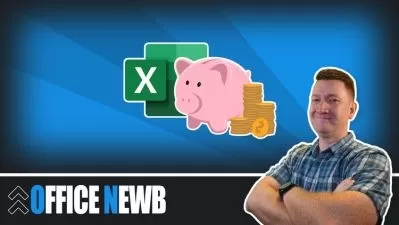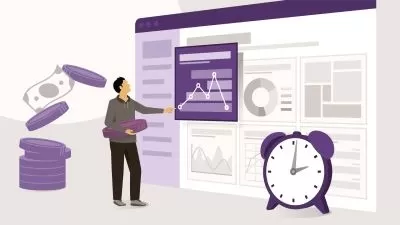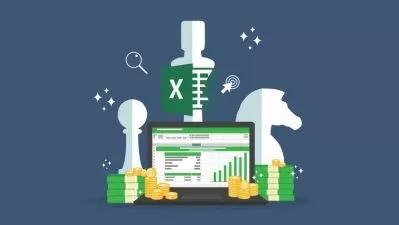Finance & Accounting for Management Consultants and Analysts
Asen Gyczew
4:17:59
Description
A practical guide that will help you understand financial statements & do financial analyses during consulting projects
What You'll Learn?
- Analyze financial statements of a firm especially income statement, balance sheet, cash flows
- Create a model of profit and loss statement (income statement) in Excel
- Analyze in Excel financial indicators and draw conclusion out of that
- Estimate the value of a firm using DCF and multiplier method
- You will understand the main difference between financial statements in USA and Europe
- You will master main bookkeeping / accounting principles
Who is this for?
What You Need to Know?
More details
DescriptionWhat is the aim of this course?
During many consulting projects, you will have to analyze financial statements (balance sheet, income statement, cash flows) and draw conclusions about a specific company. This is especially true during due diligence, strategic projects, and turn-arounds. Financial analyses require a relatively good understanding of finance and accounting. Business Analysts and Management Consultants who did not study Finance or Business tend to have some problems with navigating this area. This course will help you overcome this problem. Those of you who have finished Business School or Economics will find here a great refresher with a lot of practical tips on how to do certain analyses during a consulting project.
This course will help you drastically improve your knowledge and skills in finance and accounting. It is designed for people who are or want to become management consultants and businesses. In the course you will learn 5 main things:
How to read financial statements such as a balance sheet, an income (profit & loss) statement, cash flows
How to draw conclusions from financial statements
Main principles of accounting
How to analyze financial indicators
How to estimate the value of the firm / do valuation
I will NOT teach you everything about finance & accounting because it is simply not efficient (and frankly you don’t need it). This course is organized around the 80/20 rule and I want to teach you the most useful (from a business analyst/consultant perspective) things that will enable you to understand the financial data and analyze them.
This course is based on my 15 years of experience as a consultant in top consulting firms and as a Board Member responsible for strategy, performance improvement, and turn-arounds in the biggest firms from Retail, FMCG, SMG, B2B, and services sectors that I worked for. I have carried out or supervised over 90 different performance improvement projects in different industries that generated a total of 2 billion in additional EBITDA. On the basis of what you will find in this course, I have trained in person over 100 consultants, business analysts, and managers who now are Partners in PE and VC funds, Investment Directors and Business Analysts in PE and VC, Operational Directors, COO, CRO, CEO, Directors in Consulting Companies, Board Members, etc. On top of that my courses on Udemy were already taken by more than 224 000 students including people working in EY, Walmart, Booz Allen Hamilton, Adidas, Naspers, Alvarez & Marsal, PwC, Dell, Walgreens, Orange, and many others.
I teach through case studies, so you will have a lot of lectures showing examples of analyses, and tools that we use. To every lecture, you will find attached (in additional resources) the Excels as well as additional presentations, and materials shown in the lectures so as a part of this course you will also get a library of ready-made analyses that can, with certain modifications, be applied by you or your team in your work.
Why have I decided to create this course?
Analyzing the financial situation of the firm is a fundamental skill in consulting. It helps you understand the current situation of the firm, identify problems, and estimate potential savings. Many Management Consultants and Business Analysts did not finish Business School and sometimes struggled with some financial analyses. This sometimes puts them at a disadvantage and makes it difficult for them to get promoted. On top of that, many consultants and analysts who studied finance & accounting at university/college have forgotten some things.
Therefore, I have decided to create this course that will help students understand or refresh the essential elements of finance and accounting. The course will give you the knowledge and insight into real-life case studies that will make your life during a consulting project much easier. Thanks to this course, you will know how to understand financial statements, analyze them, and draw conclusions from them. You will also master the basics of valuation.
To sum it up, I believe that if you want to become a world-class Management Consultant or Business Analyst you have to have a pretty decent understanding of finance and accounting. That is why, I highly recommend this course to Management Consultants or Business Analysts, especially those who did not finish business school or Economics.
In what way will you benefit from this course?
The course is a practical, step-by-step guide loaded with tons of analyses, tricks, and hints that will significantly improve your knowledge of finance and accounting. There is little theory – mainly examples, and case studies with a lot of tips from my own experience as well as other notable examples worth mentioning. Our intention is that thanks to the course you will learn:
How to read financial statements such as a balance sheet, an income (profit & loss) statement, cash flows
How to draw conclusions from financial statements
Main principles of accounting
How to analyze financial indicators
How to estimate the value of the firm / do valuation
You can also ask me questions through the discussion field or by messaging me directly.
How the course is organized?
The course is divided into the following sections:
Introduction. We begin with a little intro to the course. I will show you here what you can expect from this course and how it is organized
Profit & Loss statement. In the second section, I will concentrate on the first financial statement the income statement often called the profit & loss statement (P&L). I will show you step by step all the elements of the profit and loss statement. We will also look at examples of P&Ls for firms like Amazon, Disney, P&G, and LPP. We will devote a lot of time to depreciation and amortization
Modeling of Profit & Loss Statement for FMCG Firm. In this section, I will show you an example of how to model the profit & loss statement in Excel for the FMCG business model.
Balance Sheet. In the 4th section, I will concentrate on the second financial statement – the balance sheet. As always we will go through every element of the Balance Sheet. We will also discuss the difference between the USA and European balance sheets. We will also look at examples of balance sheets for firms like Amazon, Disney, P&G, and LPP.
Cash flow statement/statement of cash flows. In this section, I will concentrate on the last financial statement – the cash flow. I will show you step by step all elements of cash flow. We will also look at examples of cash flows for firms like Amazon, Disney, P&G, and LPP.
Financial analysis of indicators. In this section, we will have a look at different sets of financial indicators that you can use to analyze a firm. We will have a look at Profitability ratios, ROE Decomposition (DuPont Model), Liquidity ratios, Activity ratios, and Debt ratios. We will also calculate them for Amazon so you can see how to use those ratios in practice.
Valuation. In the last section, we will discuss different methods of evaluating the firm (estimating its valuation). We will have a look at the DCF methods as well as the Multiplier methods. We will use a case study to see how these methods work in practice.
You will also be able to download many additional resources
Excels with analyses shown in the course
Presentation of slides shown in the course
Links to additional presentations and movies
Links to books worth reading
At the end of my course, students will be able to…
Analyze the financial statements of a firm, especially income statements, balance sheets, and cash flows
Create a model of profit and loss statement (income statement) in Excel
Analyze in Excel financial indicators and draw conclusions from that
Estimate the value of a firm using DCF and multiplier method
You will understand the main difference between financial statements in the USA and Europe
You will master the main bookkeeping/accounting principles
Who should take this course? Who should not?
Management Consultants
Business Analysts
Startups founders
Managers
Students who did not finish business school
Students who want to refresh their knowledge about Finance & Accounting
Who this course is for:
- Management Consultants
- Business Analysts
- Startups founders
- Managers
- Students who want to refresh their knowledge about Finance & Accounting
- Students without MBA / business school education
What is the aim of this course?
During many consulting projects, you will have to analyze financial statements (balance sheet, income statement, cash flows) and draw conclusions about a specific company. This is especially true during due diligence, strategic projects, and turn-arounds. Financial analyses require a relatively good understanding of finance and accounting. Business Analysts and Management Consultants who did not study Finance or Business tend to have some problems with navigating this area. This course will help you overcome this problem. Those of you who have finished Business School or Economics will find here a great refresher with a lot of practical tips on how to do certain analyses during a consulting project.
This course will help you drastically improve your knowledge and skills in finance and accounting. It is designed for people who are or want to become management consultants and businesses. In the course you will learn 5 main things:
How to read financial statements such as a balance sheet, an income (profit & loss) statement, cash flows
How to draw conclusions from financial statements
Main principles of accounting
How to analyze financial indicators
How to estimate the value of the firm / do valuation
I will NOT teach you everything about finance & accounting because it is simply not efficient (and frankly you don’t need it). This course is organized around the 80/20 rule and I want to teach you the most useful (from a business analyst/consultant perspective) things that will enable you to understand the financial data and analyze them.
This course is based on my 15 years of experience as a consultant in top consulting firms and as a Board Member responsible for strategy, performance improvement, and turn-arounds in the biggest firms from Retail, FMCG, SMG, B2B, and services sectors that I worked for. I have carried out or supervised over 90 different performance improvement projects in different industries that generated a total of 2 billion in additional EBITDA. On the basis of what you will find in this course, I have trained in person over 100 consultants, business analysts, and managers who now are Partners in PE and VC funds, Investment Directors and Business Analysts in PE and VC, Operational Directors, COO, CRO, CEO, Directors in Consulting Companies, Board Members, etc. On top of that my courses on Udemy were already taken by more than 224 000 students including people working in EY, Walmart, Booz Allen Hamilton, Adidas, Naspers, Alvarez & Marsal, PwC, Dell, Walgreens, Orange, and many others.
I teach through case studies, so you will have a lot of lectures showing examples of analyses, and tools that we use. To every lecture, you will find attached (in additional resources) the Excels as well as additional presentations, and materials shown in the lectures so as a part of this course you will also get a library of ready-made analyses that can, with certain modifications, be applied by you or your team in your work.
Why have I decided to create this course?
Analyzing the financial situation of the firm is a fundamental skill in consulting. It helps you understand the current situation of the firm, identify problems, and estimate potential savings. Many Management Consultants and Business Analysts did not finish Business School and sometimes struggled with some financial analyses. This sometimes puts them at a disadvantage and makes it difficult for them to get promoted. On top of that, many consultants and analysts who studied finance & accounting at university/college have forgotten some things.
Therefore, I have decided to create this course that will help students understand or refresh the essential elements of finance and accounting. The course will give you the knowledge and insight into real-life case studies that will make your life during a consulting project much easier. Thanks to this course, you will know how to understand financial statements, analyze them, and draw conclusions from them. You will also master the basics of valuation.
To sum it up, I believe that if you want to become a world-class Management Consultant or Business Analyst you have to have a pretty decent understanding of finance and accounting. That is why, I highly recommend this course to Management Consultants or Business Analysts, especially those who did not finish business school or Economics.
In what way will you benefit from this course?
The course is a practical, step-by-step guide loaded with tons of analyses, tricks, and hints that will significantly improve your knowledge of finance and accounting. There is little theory – mainly examples, and case studies with a lot of tips from my own experience as well as other notable examples worth mentioning. Our intention is that thanks to the course you will learn:
How to read financial statements such as a balance sheet, an income (profit & loss) statement, cash flows
How to draw conclusions from financial statements
Main principles of accounting
How to analyze financial indicators
How to estimate the value of the firm / do valuation
You can also ask me questions through the discussion field or by messaging me directly.
How the course is organized?
The course is divided into the following sections:
Introduction. We begin with a little intro to the course. I will show you here what you can expect from this course and how it is organized
Profit & Loss statement. In the second section, I will concentrate on the first financial statement the income statement often called the profit & loss statement (P&L). I will show you step by step all the elements of the profit and loss statement. We will also look at examples of P&Ls for firms like Amazon, Disney, P&G, and LPP. We will devote a lot of time to depreciation and amortization
Modeling of Profit & Loss Statement for FMCG Firm. In this section, I will show you an example of how to model the profit & loss statement in Excel for the FMCG business model.
Balance Sheet. In the 4th section, I will concentrate on the second financial statement – the balance sheet. As always we will go through every element of the Balance Sheet. We will also discuss the difference between the USA and European balance sheets. We will also look at examples of balance sheets for firms like Amazon, Disney, P&G, and LPP.
Cash flow statement/statement of cash flows. In this section, I will concentrate on the last financial statement – the cash flow. I will show you step by step all elements of cash flow. We will also look at examples of cash flows for firms like Amazon, Disney, P&G, and LPP.
Financial analysis of indicators. In this section, we will have a look at different sets of financial indicators that you can use to analyze a firm. We will have a look at Profitability ratios, ROE Decomposition (DuPont Model), Liquidity ratios, Activity ratios, and Debt ratios. We will also calculate them for Amazon so you can see how to use those ratios in practice.
Valuation. In the last section, we will discuss different methods of evaluating the firm (estimating its valuation). We will have a look at the DCF methods as well as the Multiplier methods. We will use a case study to see how these methods work in practice.
You will also be able to download many additional resources
Excels with analyses shown in the course
Presentation of slides shown in the course
Links to additional presentations and movies
Links to books worth reading
At the end of my course, students will be able to…
Analyze the financial statements of a firm, especially income statements, balance sheets, and cash flows
Create a model of profit and loss statement (income statement) in Excel
Analyze in Excel financial indicators and draw conclusions from that
Estimate the value of a firm using DCF and multiplier method
You will understand the main difference between financial statements in the USA and Europe
You will master the main bookkeeping/accounting principles
Who should take this course? Who should not?
Management Consultants
Business Analysts
Startups founders
Managers
Students who did not finish business school
Students who want to refresh their knowledge about Finance & Accounting
Who this course is for:
- Management Consultants
- Business Analysts
- Startups founders
- Managers
- Students who want to refresh their knowledge about Finance & Accounting
- Students without MBA / business school education
User Reviews
Rating
Asen Gyczew
Instructor's Courses
Udemy
View courses Udemy- language english
- Training sessions 106
- duration 4:17:59
- English subtitles has
- Release Date 2024/02/03

















